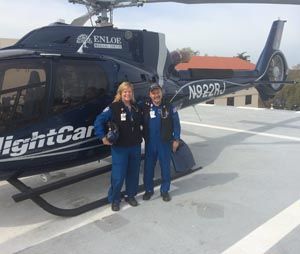Jim Cuneo has nothing against nine-to-five jobs. Someday he might even like one. For now, though, the 57-year-old flight paramedic enjoys earning a living 24 hours at a time for Enloe Flight Care in Chico, California.
“It’s not just the calls,” says Cuneo, “it’s the people I work with.”
Those people include six flight nurses, four flight medics and four pilots who rotate aboard a brand new EC-130 T2 EcoStar helicopter – the first of its kind to be configured as an air ambulance, with better medical hardware and “tons more room” than previous models, according to Cuneo.
Even with state-of-the-art safety features and avionics, though, prehospital care at 1,000 feet and 135 miles per hour is never quite routine.
“One time we flew into what we thought was just a little cloud but it turned out to be a fog bank” Cuneo says. “We lost visual reference for a while. Our helicopter isn’t equipped for IFR (instrument flight rules), so that was scary for about five minutes.”
Cuneo enjoys the mission-critical nature of aviation despite the risks.
“I like knowing I’ll be handling emergent patients every shift. I’ve always enjoyed the challenge of treating the most serious cases.”
Pre-Med to paramedic
There was a time when Cuneo thought he’d be practicing medicine in a hospital instead of a helicopter.
“I was pre-med – a biology major,” he says, “but with my grades, I must have been delusional about getting into medical school. I’m pretty sure I wouldn’t have made it through four years.”
Cuneo first considered EMS when he spent a semester at the National Institute of Health in Washington D.C.
“I volunteered in one of their research labs,” he says. “You’d donate your blood and let them do little tests on you in return for your training. I got certified in CPR while I was there and wanted to do more of that sort of thing. After I got my bachelor’s, I went right into the medic program at Butte College.”
(Cuneo likes to point out that Butte is the original alma mater of noted non-EMS-provider Aaron Rodgers, who is also the correct answer to the trivia question, Which NFL quarterback could have gone to medic school instead of the Super Bowl?)
Cuneo had one of his most memorable patients during clinical rotations.
“She was a 50-year-old female with a pulmonary embolism,” says Cuneo. “She coded but we got her back.
“I was holding her hand when she woke up. She remembered that and for 10 years, on the anniversary of her arrest, she’d bring me a rose. Even though I didn’t really have much to do with resuscitating her, she seemed to feel I was her guardian angel.”
From the ground up
 |
| Cuneo with Flight Nurse Eliza Anderson in front of their ride. |
After graduating from Butte in 1983, Cuneo took a job at Chico Paramedic Rescue, a hospital-based ambulance service in that northern California city of 90,000. He became good friends with his boss, Marcus Whitacre.
“I always respected and admired him,” Cuneo says. “He was a one-on-one kind of guy who really valued you as a person and accepted you despite your faults.”
Sadly, Whitacre died in a dirt bike accident in 1991. Cuneo had left Chico for Oroville Hospital Ambulance by then and was also working part time for Enloe.
By 2001 he was with Enloe full time. He liked the fast pace of HEMS.
“It’s a challenge to see through the chaos and manage those crazy calls,” he says. “You never really know how you’ll do until you’re out there. You just rely on your training and do the best you can.”
Cuneo also went back to Butte – this time as a faculty member in their EMT program. The 32-year EMS veteran discovered he enjoys teaching almost as much as flying.
“There are so many things involved administratively, but the main thing for me is just sharing the passion I feel with the students,” Cuneo says. “I think we’ve been raising the bar for them, and they’ve responded by learning more.
“EMS is constantly changing; STEMI and stroke programs are good examples. Now when people come to us with serious conditions, there’s a good chance they’ll end up walking away. A lot of that has to do with better orientation between hospitals and the field.”
Cuneo thinks a solid foundation in core subjects like anatomy and physiology is necessary but not sufficient to succeed in EMS.
“You have to keep your eyes wide open and make sense of what’s going on, to think past what you see and ask really good questions,” Cueno says. “It’s more than just finding out your patient has a headache or a backache. What might be causing it? Learning to do a really good assessment takes time. Mostly, you have to like talking to people.”
Cuneo says he’s approaching a point in his career where he wouldn’t mind doing more talking and less flying, particularly if he could swap 24-hour shifts for eight-hour days.
“As I get closer to retirement, I can see myself more involved in teaching,” he says. “It’s really helped me maintain my enthusiasm for EMS. A lot of students I see have no idea what they’re getting into. Maybe I can help with their transition.”
Even at sea level.













